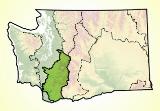 © Pete Saloutos/Panoramic Images (Washington Title Image Large)
© Pete Saloutos/Panoramic Images (Washington Title Image Large)

West Cascades Human Impact
The low elevation ecosystems of the West Cascades have borne the greatest changes from human activities. Threats to biodiversity include:
- Past forest management practices. Extensive timber harvesting and its accompanying road building have altered the complex ecological functions of lowland forests. Multi-aged forests have been replaced with even-aged stands.
- Habitat fragmentation and loss. Patchworks of ownership and management at lower elevations complicate biodiversity conservation efforts. Conversion to residential and commercial uses puts landscape continuity in jeopardy.
- Invasive species. Non-native and invasive plant and animal species pose a serious threat to ecoregional biodiversity.
This forested and mountainous ecoregion is near several urban centers, creating challenges to its future ecological integrity. Forward-thinking partnerships are looking for ways to conserve both the vitality of farms and working forests and the biodiversity of this ecoregion.
For details of this ecoregion within Washington, click a subheading in the left column.
View the more general description of this ecoregion in North America



